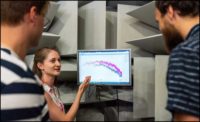Commercial building automation has come a long way over the years. Many strides in technology have contributed to the changes we have experienced over the years. In the future, building automation will continue to evolve, and with new breakthroughs in machine learning, we are now at a new beginning in many ways.
In the 1960s and ‘70s, building automation was primarily pneumatic controls. It’s quite incredible what can be controlled using just air signals. However, these systems were only as good as the maintenance and calibration of the equipment. Many control strategies were able to be utilized, but constant tweaking and adjustments were required for temperature and occupancy.
In the 1980s, we started to see an introduction to digital controls. This allowed us to have more precise control of the systems and also started to eliminate some of the downsides of using air-based control systems. Energy efficiency was just starting to be taken more into consideration as well. In the 1990s, computers were now more prevalent and normal within buildings.
The turn of the century is when real advancements started to take place. In the 2000s, we had the rise of the internet. We had breakthroughs in control languages, such as BACnet and LonWorks. We were now at a time when we could start integrating different components and control systems in a more seamless manner. Web-based platforms were starting to rise, allowing remote monitoring for control systems and making facility management more accessible and convenient.
In the past decade, we have moved into the smart building generation. Collecting vast amounts of data is now the norm. We have fine-tuned ways of optimizing performance, energy efficiency, and tenant comfort. Connecting different brands and systems is much more seamless, and we can provide just about any type of control configuration as long as we have the right data and sensors.
There is really nothing off the table at this point, but how much farther can we really go?
In the next 10 years, we will see massive strides in AI and machine learning. AI will help us optimize parts of buildings that did not seem possible. Instead of optimizing based on current weather and occupancy, machine learning will allow us to optimize our buildings based on the predicted weather forecast and the learned habits of our tenants. Anyone who has a cellphone has noticed that without letting our phones know where we work or what days we are at certain places, our phones seem to predict our habits. On Fridays, I like to stop for coffee at Starbucks, but on other days of the week, I do not. After many weeks of doing this, my phone will pop up the time it takes to get there but only on Friday, yet every other day of the week it has my work location as my leaving destination. Our building automation systems (BASs) will start to learn these habits and optimize routines based on them bringing a new way to optimize efficiency.
Smart grid integration will be another large step for commercial buildings. Being connected to the power grid and able to talk back and forth, we will start to see dynamic load management and peak demand reduction as a more automated and seamless process. AI will allow us to forecast ahead of time and be aware of estimated surges days before they happen and adjust accordingly without human interaction.
Indoor environment monitoring will have new strides beyond our basic ventilation and temp control. Detailed monitoring of lighting conditions, IAQ, occupancy, and productivity will allow dynamic changes that care equally about an occupant's well-being not just their comfort. These systems will all be real-time and dynamic.
Monitoring a building's environmental impact and sustainability in real time will become the norm. When all of the above is monitored, we can have a true estimate in real time of where our power is coming from and the impact our building is having on the environment and power grid. Talks about net-zero buildings and carbon footprint will become more and more prevalent.
Energy storage within buildings will become a sought-after technology that pairs well with dynamic integration into our smart grids in the country.
We have very exciting changes in building automation coming very quickly. With the rapid rise in machine learning, now is the time to start reading and learning about the various technologies coming. As you can see from our history above, we are not just starting to move fast, we have been moving fast the entire time.





